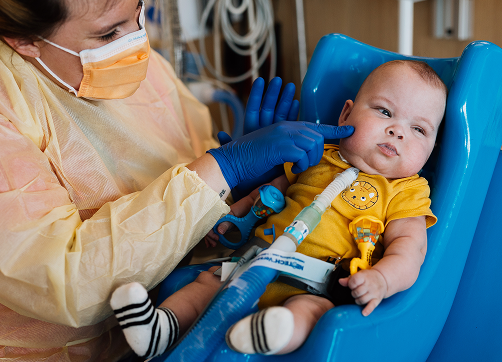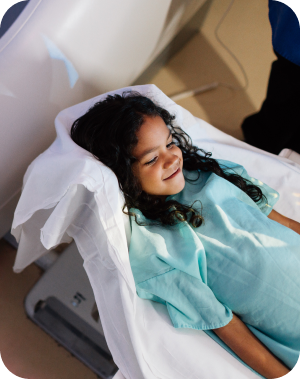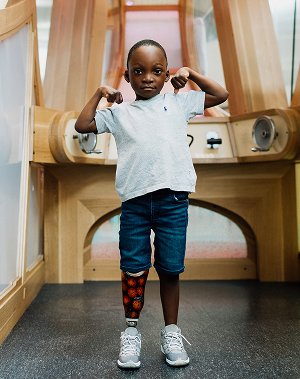goldenhar syndrome


about condition
Goldenhar syndrome (GS), is one of similar conditions known under the Oculo-Auriculo-Vertebral spectrum (OAV). This congenital occurrence affects one in every 3,000 to 5,000 births, with the severity of the syndrome varying widely among affected individuals. GS causes incomplete development of bones in the face and skull which affect the eyes, ears, nose, palate and jaw. Typically, this occurs mostly on one side of the face; although some individuals have the syndrome bilaterally. The condition can also cause spine and ribcage malformations, along with heart, kidney, lungs and nervous system issues. Maurice Goldenhar, an ophthalmologist and general practitioner, identified the syndrome in 1952.
characteristics and symptoms of Goldenhar may include:
- Underdeveloped facial and skull bone
- Facial asymmetry; weak muscles
- Eye non-cancerous growths (ocular dermoid cysts); eyesight issues
- Underdeveloped cheekbones (malar hypoplasia)
- Absent/malformed shaped outer ears (anotia/microtia)
- Missing or narrow ear canals (atresia/stenosis)
- Middle ear / inner ear malformations
- Opening in roof of mouth (cleft palate) or soft palate
- Cleft lip (less common)
- Small/recessed jaw (micrognathia); airway issues
- Conductive and/or sensorineural hearing loss often requiring hearing aids or hearing processors
- Missing or joined ribs
- Missing, joined or misshapen bones of the spine; curved spine (scoliosis)
- Sleep apnea (sometimes requiring intervention as growth occurs)
- Nervous system issues
- Eating and speech difficulties
more rare:
- Opening between the trachea and esophagus
- Thoracic insufficiency syndrome (chest wall malformation interfering with lung function and development)
how do I know if my child will be born with Goldenhar?
Sometimes when an ultrasound is performed during pregnancy, a doctor may notice non-typical signs which require additional testing. The ultrasound may reveal an absent ear, possible cleft palate, or there may be extra amniotic fluid which may indicate the baby could have a craniofacial condition. Presently, there is no known method of genetic testing for parents to identify Goldenhar in pregnancy or otherwise. (Genetic testing can be done if another condition is suspected.) After birth, a clinical exam can help determine if your baby has Goldenhar syndrome. More testing such as x-rays of the bones, fetal MRI (magnetic resonance imaging) and fetal echocardiogram (heart ultrasound scan) can also be performed to evaluate the kidneys and heart.


how do you treat Goldenhar syndrome?
The treatment of GS is directed toward the specific symptoms that are apparent in each individual since the symptoms can vary widely across the OAV spectrum. Some children may need facial reconstruction and/or jaw surgery to improve the airway. Some issues with Goldenhar may only become evident as your child grows. This is often true for spinal malformations, such as scoliosis, dislocated hips and joint disorders. Treatment may include non-surgical options such as bracing and physical therapy, surgery such as spinal fusion or other options for stabilizing the spine as your child grows.
Our specialists work together to ensure a comprehensive approach to treatment. These specialists may include pediatricians, craniofacial and reconstructive surgeons, specialists who treat the ears, nose, and throat (ENT/otolaryngologists), eye specialists (ophthalmologists), heart (cardiologists), lungs (pulmonary), kidneys (nephrologists), urinary tract (urologists), digestive tract (gastroenterologists), hearing loss (audiologists and otologists), speech pathologists, specialists for the spine, orthodontic and dental care, along with other care team professionals.
faqs
Unfortunately, due to the lack of data, the estimations are quite varied. Most data states GS occurs one in every 3000 to 5000 births, while other data suggests it is less frequent between 10,000 and 25,000 births.
Yes, GS is a birth occurrence. Most cases are sporadic and happen in families with no previous history of the syndrome, which means it is unlikely the syndrome was inherited (following an autosomal dominant or recessive pattern). A dominant pattern means if one parent has the syndrome, each of their children has a 50% chance of inheriting the condition. Researchers don’t have enough information but believe most individuals with Goldenhar have a very low chance of having a child with the syndrome. Studies suggest that only between one and two percent of cases are inherited from a parent. In these cases, it will be either an autosomal dominant or recessive occurrence but the genes responsible are currently unknown.
Even though surgeries are often in their future, individuals with GS can have a normal life span like anyone else.
At present, there are no known genes (or chromosomes) responsible for causing GS; more research needs to done.
(The OAV spectrum and Goldenhar syndrome names are commonly used interchangeably)
Other names for Oculo-Auriculo-Vertebral Spectrum:
- Facio-Auriculo-Vertebral Spectrum
- FAV
- First and Second Branchial Arch Syndrome
- Goldenhar-Gorlin Syndrome
- OAVS
- Oculo-Auriculo-Vertebral Dysplasia
Subdivisions of Oculo-Auriculo-Vertebral Spectrum
- Goldenhar Syndrome
- Hemifacial Microsomia (HFM)
- Oculo-Auriculo-Vertebral Syndrome
here when you need us
Whether you’re looking for the right provider, ready to make an appointment, or need care right now—we’re here to help you take the next step with confidence.
